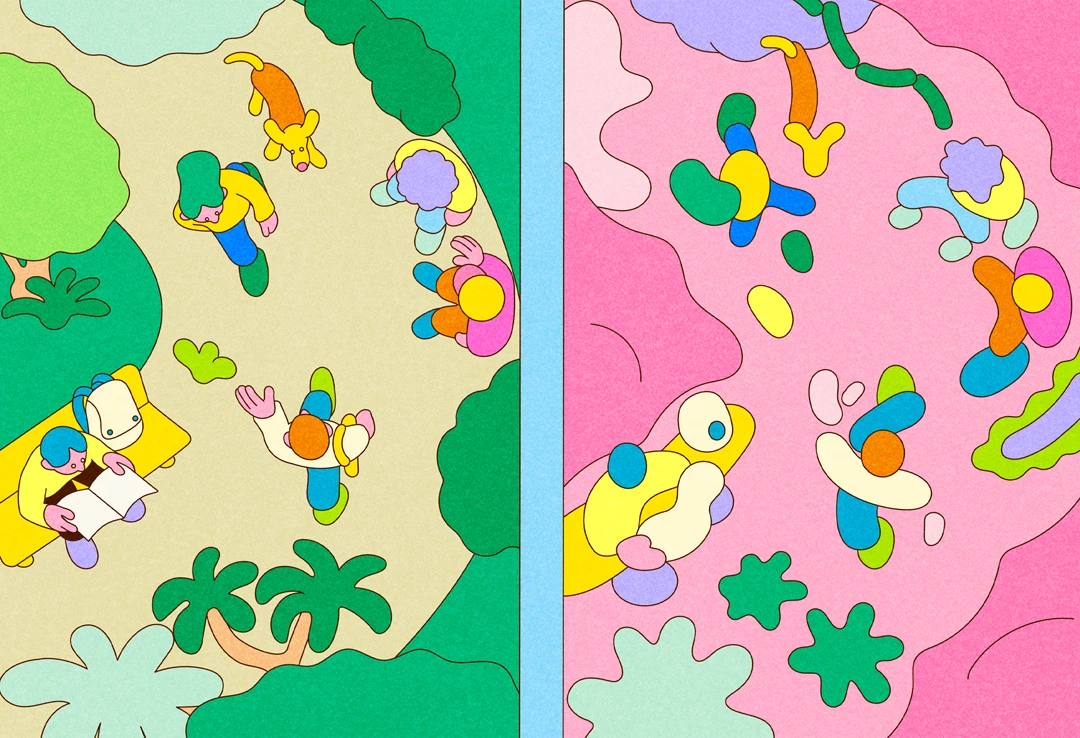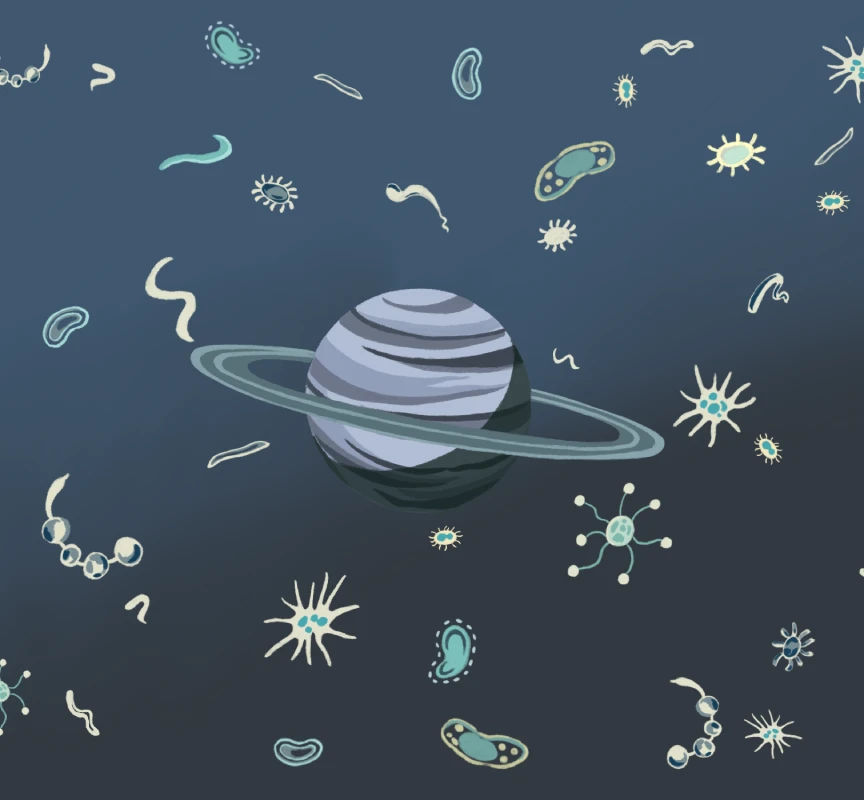Feature
“Microorganisms Are With Us at This Very Moment.” We Asked Kohei Ito From Biota About the Symbiotic Relationship Between Humans and Invisible Things

Index
Cities for Humans and Intestines for Bacteria Share Similarities
Developing a Sensitive and Caring Touch with Nature
Microorganisms as the Infrastructure of a City
Cycle Means to Engage with Diverse Living Things and Resources
In Issue 3, we introduced fermentation, and now, in our fourth issue, we’re diving into the world of microorganisms, the powerhouse behind fermentation. Kohei Ito, an entrepreneur and the face behind BIOTA Inc., believes that microorganisms are as essential as electricity, water, gas, trains, and roads in supporting our daily lives.
Kohei aims to design cities where people can live healthy and secure lives by enhancing microbial diversity in urban landscapes and architecture.
Though invisible to the naked eye, microorganisms are everywhere—on our hands and throughout our bustling cities. While they can sometimes be harmful, they are vital to our existence.
Let’s explore the fascinating world of microorganisms from Kohei Ito’s perspective.
Cities for Humans and Intestines for Bacteria Share Similarities
In your research, you investigate and analyze microorganisms in cities. What kinds of microorganisms are found in the cities where we live?

Ito
For example, train straps are covered with microorganisms commonly found on people’s hands, while toilets harbor bacteria typically found in people’s intestines. The microorganisms in a city are basically determined by human activities in that place. The same species of microorganisms found in deserts are also found in boilers used for hot water and heating in apartment buildings, hospitals, and office buildings because they can withstand the heat and survive there. Similarly, sewers host microorganisms that can adapt to the various chemicals flowing through them. Human behavior significantly impacts various living things in unseen places.
What specific microorganisms are found in the places you mentioned?

Ito
On human hands, you might find Staphylococcus aureus and Propionibacterium acnes, while Escherichia coli is a typical example of intestinal bacteria. However, rather than focusing on individual microorganisms, it’s essential to view them as a network. For instance, the intestines contain 500 to 1,000 species of microorganisms, and understanding their interactions is crucial.
Humans behave and make decisions differently when alone versus in a group. Each person has limited abilities individually, but when people come together and interact, they can achieve much more. Similarly, cities for humans and intestines for bacteria can be seen as the same “living space”—the structure is the same, only the scale is different.

So the same dynamics occur in the microbial world as in our society. We should probably say that our society is similar to the world of microorganisms, which has existed far longer than humans have.

Ito
The microbial world has a much more diverse society than ours. New species are emerging rapidly, likely faster than our research can keep up. Therefore, the approach of “we don’t know what they are, so let’s sterilize and disinfect them” is reaching its limit.
We need to accept that we don’t know everything and find ways to coexist with microorganisms. We should embrace this kind of tolerance. After all, there are about 38 trillion microorganisms in the human body—they are “with us at this very moment.”
Developing a Sensitive and Caring Touch with Nature
Since the COVID-19 pandemic, there has been a heightened emphasis on sterilization and disinfection. However, it’s crucial to consider creating environments where people and microorganisms can coexist rather than simply eliminating them. Am I getting it right?

Ito
Continued excessive and inappropriate sterilization and disinfection can lead to the rise of drug-resistant bacteria. This occurs when microorganisms develop resistance to antibiotics used for treating diseases and to antibacterial chemicals found in paints, toothpaste, detergents, and other products through mutations. Such environments may increase the risk of contracting infectious and other diseases.
The primary source of microorganisms in cities is believed to be humans, with individuals releasing approximately 1 million microorganisms per hour. This means densely populated areas have significantly higher microorganism concentrations, which is why infectious diseases spread easily in crowded and public spaces.
It’s essential to distinguish between human-origin and naturally occurring microorganisms. Each type has its own ecological niche—microorganisms transferred to humans typically originate from the human body and cannot survive in natural environments like soil.
As cities grow increasingly crowded, the number of human-derived microorganisms is believed to have surged to excessive levels. However, reducing the overall microorganism count is challenging as urban populations expand. In response, creating a competitive environment for human-derived microorganisms is crucial. This involves boosting the presence of naturally occurring microorganisms in cities, such as those found in soil and plants. This approach aims to enhance microbial diversity through urban development practices.

What is interesting about studying microorganisms in cities compared to natural environments?

Ito
There may be a perception that human activities like constructing buildings and cities negatively impact the local ecosystem. However, I believe that human intervention in nature isn’t inherently bad, as long as it’s done with sensitivity and care. Of course, I’m against clearing forests without regard for the creatures living there, but building construction can potentially create new habitats for various living organisms.
Can human intervention sometimes enhance the ecosystem, like how pickles become tastier when stirred?

Ito
Yes, it seems the taste of pickles changes because the microorganisms on the pickles vary depending on the person’s hands who stirs them. Conversely, people also acquire microorganisms from the nukadoko (pickling bed). This interaction with microorganisms is a theme we’re particularly interested in.
I’ve also published a preprint of a paper stating that people and dogs living together develop similar intestinal bacteria. The same goes for couples and families who live together. We know that intestinal bacteria influence emotions, and more than half of brain transmitters, such as serotonin and dopamine, are produced by intestinal bacteria. It’s not surprising that similar intestinal bacteria can lead to similar sensations and emotions. I believe a kind of bond is created through microorganisms.

Microorganisms as the Infrastructure of a City
I was impressed by “GreenAir,” the microbial diffuser you developed to increase microbial diversity.

Ito
The goal of GreenAir is to create a kind of “yogurt” for cities. Just as people consume yogurt to introduce beneficial bacteria into their bodies for better health, I thought we could create something to add microorganisms to urban environments. However, GreenAir is only effective in the short term, spanning 10 to 20 years. Ultimately, I want to create a world where GreenAir isn’t necessary. My goal is to establish a state where cities have inherent microbial diversity without the need to consciously add bacteria, which is why I focus on landscape and architectural design.
I believe that microorganisms are the infrastructure of a city. They may not be visible on the surface, but they play a crucial behind-the-scenes role that we couldn’t do without.
Is your collaboration in the “Microbes actually are all around” exhibition at the Miraikan part of your efforts to raise awareness about the microorganisms that support us?

Ito
Yes, our approach involves two main axes: science, which explores and solves problems through reason, and art, which explores and asks questions through sensibility. I believe it’s necessary not only to find solutions but also to pose questions about future challenges. That’s why we collaborate not only with researchers but also with artists and chefs.

Cycle Means to Engage with Diverse Living Things and Resources
What kind of perspective is needed for us to recognize the presence of microorganisms in our daily lives?

Ito
We humans are now able to recognize the existence of microorganisms due to advances in microscopy, genome analysis, and other technologies. However, this doesn’t necessarily mean we can truly perceive microorganisms with a true sense of reality.
No matter how much progress humanity makes, we will never be able to see microorganisms with the naked eye. That’s why it’s important to be aware of their activities, even when they are invisible.
For example, if the area where hot spring water flows changes color to yellow or green, it indicates that microorganisms have oxidized or reduced sulfur there. Similarly, food scraps disappearing quickly in compost or bubbles forming in yeast starter for sake are signs of microbial activity. Even though we can’t see the microorganisms themselves, they are engaging in a kind of dialogue. There are plenty of opportunities to notice these interactions in our daily lives.

I would like to develop the sensitivity to sense microorganisms even if I can’t see them. Finally, could you please share your approach to fostering a sustainable relationship with microorganisms?

Ito
Earth is home to not only microorganisms but also various other living things. Since we share this planet, I want to explore ways for humans to better engage with other living creatures.
As I mentioned in the first issue of Monthly JP pavilion, I believe it’s crucial to improve our understanding of waste disposal to achieve a true cycle. Instead of refraining from using something, we should focus on disposing of it in a way that it can be returned to other living things. With this mindset, I believe that one day, until the end of the earth’s life, humans can enjoy being an irreplaceable part of the ecosystem.
Thinking about cycles and sustainability means engaging with the earth’s diverse living creatures and abundant resources.


Kohei Ito
Kohei graduated from the Faculty of Environment and Information Studies at Keio University. He has been involved in genome analysis of normal microbiota since his high school days as a special research student at the Institute for Advanced Biosciences, Keio University. During his undergraduate years, he focused on metagenome analysis of microbial communities in various environments. After completing his studies, he founded BIOTA, Inc. and has since been leading urban design projects aimed at enhancing microbial diversity.
Illustration: Ayumi Takahashi
Let’s Share!
Microorganisms and humans are both irreplaceable members of the ecosystem!
Share your Monthly JP pavilion and circulate your thoughts.
Related Articles

02/03
Did Microorganisms Come from Space?
Thinking about the Cosmic Scale of CyclesCan microorganisms survive in extreme environments? Let's explore the various theories related to the origin of life.
Read more
03/03
Harnessing Methane Fermentation Power: Meet the Biogas Rangers Saving Our Planet!
The Biogas Rangers, who save the Earth with the power of fermentation! Behold the power of methane!
Read more